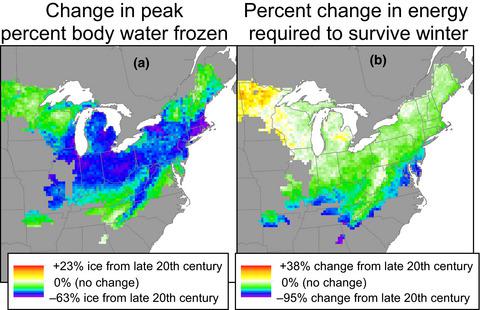当前位置:
X-MOL 学术
›
Glob. Change Biol.
›
论文详情
Our official English website, www.x-mol.net, welcomes your feedback! (Note: you will need to create a separate account there.)
Future winters present a complex energetic landscape of decreased costs and reduced risk for a freeze-tolerant amphibian, the Wood Frog (Lithobates sylvaticus).
Global Change Biology ( IF 11.6 ) Pub Date : 2020-09-01 , DOI: 10.1111/gcb.15321 Megan J Fitzpatrick 1, 2 , Warren P Porter 2 , Jonathan N Pauli 1 , Michael R Kearney 3 , Michael Notaro 4 , Benjamin Zuckerberg 1
Global Change Biology ( IF 11.6 ) Pub Date : 2020-09-01 , DOI: 10.1111/gcb.15321 Megan J Fitzpatrick 1, 2 , Warren P Porter 2 , Jonathan N Pauli 1 , Michael R Kearney 3 , Michael Notaro 4 , Benjamin Zuckerberg 1
Affiliation

|
Winter climate warming is rapidly leading to changes in snow depth and soil temperatures across mid‐ and high‐latitude ecosystems, with important implications for survival and distribution of species that overwinter beneath the snow. Amphibians are a particularly vulnerable group to winter climate change because of the tight coupling between their body temperature and metabolic rate. Here, we used a mechanistic microclimate model coupled to an animal biophysics model to predict the spatially explicit effects of future climate change on the wintering energetics of a freeze‐tolerant amphibian, the Wood Frog (Lithobates sylvaticus), across its distributional range in the eastern United States. Our below‐the‐snow microclimate simulations were driven by dynamically downscaled climate projections from a regional climate model coupled to a one‐dimensional model of the Laurentian Great Lakes. We found that warming soil temperatures and decreasing winter length have opposing effects on Wood Frog winter energy requirements, leading to geographically heterogeneous implications for Wood Frogs. While energy expenditures and peak body ice content were predicted to decline in Wood Frogs across most of our study region, we identified an area of heightened energetic risk in the northwestern part of the Great Lakes region where energy requirements were predicted to increase. Because Wood Frogs rely on body stores acquired in fall to fuel winter survival and spring breeding, increased winter energy requirements have the potential to impact local survival and reproduction. Given the geographically variable and intertwined drivers of future under‐snow conditions (e.g., declining snow depths, rising air temperatures, shortening winters), spatially explicit assessments of species energetics and risk will be important to understanding the vulnerability of subnivium‐adapted species.
中文翻译:

未来的冬天呈现出复杂的充满活力的景象,即降低了成本,降低了耐冻两栖动物伍德蛙(Lithobates sylvaticus)的风险。
冬季气候变暖正迅速导致中高纬度生态系统的积雪深度和土壤温度发生变化,这对在雪底越冬的物种的生存和分布具有重要意义。由于两栖动物的体温与新陈代谢速率之间存在紧密的联系,因此它们尤其容易受到冬季气候变化的影响。在这里,我们使用了一种机制微气候模型,再加上一种动物生物物理模型,来预测未来气候变化对耐冻两栖动物伍德蛙(Lithobates sylvaticus)的越冬能量的空间影响。),分布在美国东部。我们的雪下微气候模拟是由区域气候模型与Laurentian大湖区的一维模型一起动态缩小的气候预测驱动的。我们发现,土壤温度的升高和冬季长度的减少对Wood Frog冬季能源需求产生了相反的影响,从而导致Wood Frogs在地理上存在异质性。尽管在整个研究区域的大部分地区,蛙类的能量消耗和最高冰含量预计都将下降,但我们在大湖区西北部发现了能量需求增加的高能风险区域。由于伍德蛙(Wood Frogs)依靠秋季收购的人体商店来促进冬季生存和春季繁殖,冬季能源需求的增加可能会影响当地的生存和繁殖。考虑到未来低雪条件(例如,降雪深度下降,气温上升,冬季缩短)的地理因素和相互交织的驱动因素,对物种能量和风险进行空间明确的评估对于了解适应亚亚适应性物种的脆弱性很重要。
更新日期:2020-10-19
中文翻译:

未来的冬天呈现出复杂的充满活力的景象,即降低了成本,降低了耐冻两栖动物伍德蛙(Lithobates sylvaticus)的风险。
冬季气候变暖正迅速导致中高纬度生态系统的积雪深度和土壤温度发生变化,这对在雪底越冬的物种的生存和分布具有重要意义。由于两栖动物的体温与新陈代谢速率之间存在紧密的联系,因此它们尤其容易受到冬季气候变化的影响。在这里,我们使用了一种机制微气候模型,再加上一种动物生物物理模型,来预测未来气候变化对耐冻两栖动物伍德蛙(Lithobates sylvaticus)的越冬能量的空间影响。),分布在美国东部。我们的雪下微气候模拟是由区域气候模型与Laurentian大湖区的一维模型一起动态缩小的气候预测驱动的。我们发现,土壤温度的升高和冬季长度的减少对Wood Frog冬季能源需求产生了相反的影响,从而导致Wood Frogs在地理上存在异质性。尽管在整个研究区域的大部分地区,蛙类的能量消耗和最高冰含量预计都将下降,但我们在大湖区西北部发现了能量需求增加的高能风险区域。由于伍德蛙(Wood Frogs)依靠秋季收购的人体商店来促进冬季生存和春季繁殖,冬季能源需求的增加可能会影响当地的生存和繁殖。考虑到未来低雪条件(例如,降雪深度下降,气温上升,冬季缩短)的地理因素和相互交织的驱动因素,对物种能量和风险进行空间明确的评估对于了解适应亚亚适应性物种的脆弱性很重要。


























 京公网安备 11010802027423号
京公网安备 11010802027423号